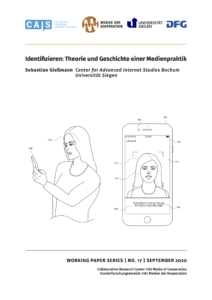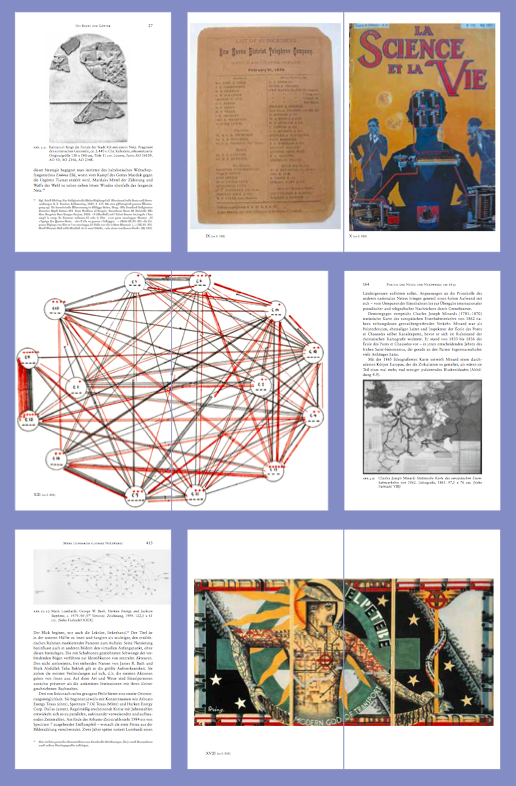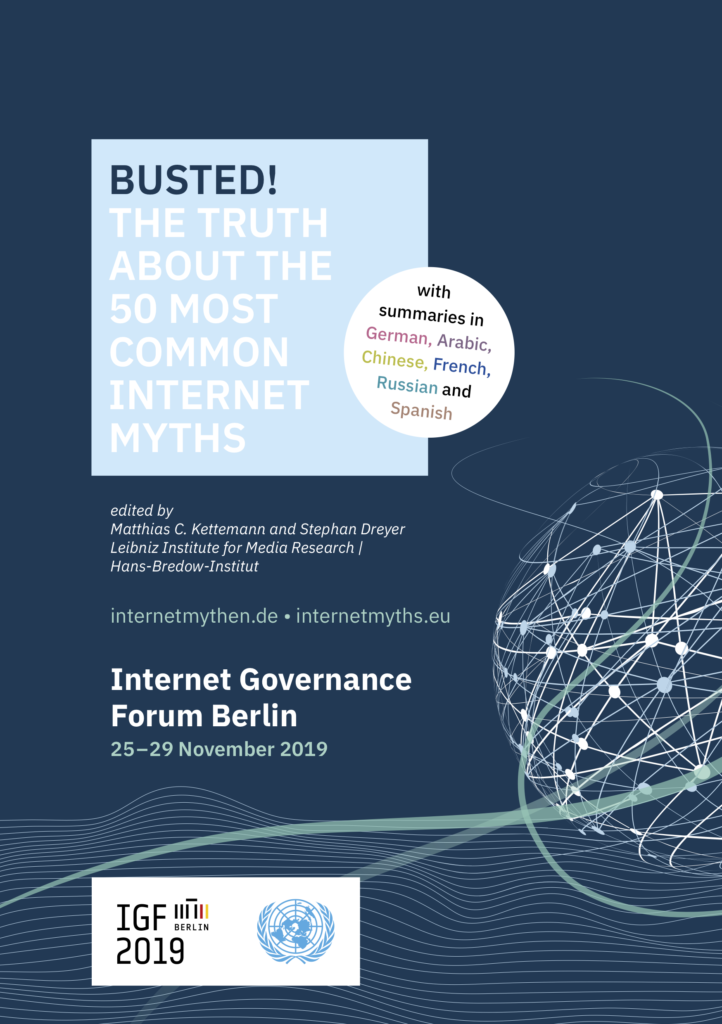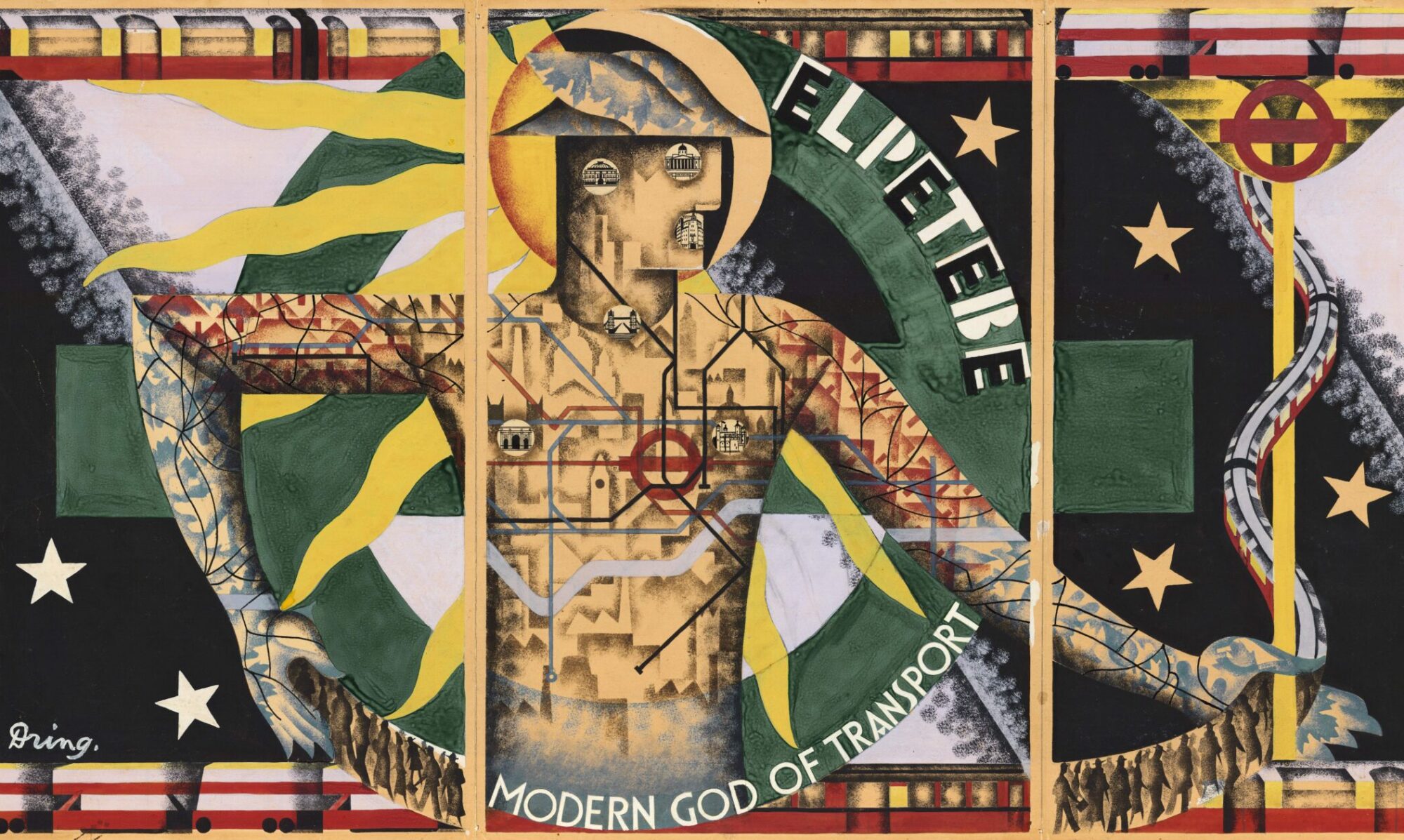Medien sind der Maßstab aller Praxis.
— Sebastian Gießmann (@sebgiessmann) September 23, 2020
Identifizieren: Theorie und Geschichte einer Medienpraktik
 Registrieren, Identifizieren und Klassifizieren sind Praktiken, die in digitalen Kulturen kaum mehr zu trennen sind. Anhand der Mediengeschichte des Passes und der Kreditkarte geht der folgende Text der Frage nach, wie immer neue infrastrukturelle Kaskaden des Identifizierens entstehen und welche öffentliche Brisanz den entsprechenden Datenverarbeitungen innewohnt. Beim Identifizieren handelt es sich um eine ko-operative Medien- und Datenpraktik, an der stets mehr als eine Person beteiligt ist. Sie involviert von Anfang an menschliche Körper samt ihrer semiotischen Ressourcen und koppelt diese mit bürokratischen Aufschreibesystemen. Auch die neuesten digitalen Prozeduren greifen bevorzugt auf Gesichter und Fingerabdrücke zu: Biometrie versucht, den für das Identifizieren konstitutiven Abstand zwischen Konten, Körpern und Personen aufzuheben.
Registrieren, Identifizieren und Klassifizieren sind Praktiken, die in digitalen Kulturen kaum mehr zu trennen sind. Anhand der Mediengeschichte des Passes und der Kreditkarte geht der folgende Text der Frage nach, wie immer neue infrastrukturelle Kaskaden des Identifizierens entstehen und welche öffentliche Brisanz den entsprechenden Datenverarbeitungen innewohnt. Beim Identifizieren handelt es sich um eine ko-operative Medien- und Datenpraktik, an der stets mehr als eine Person beteiligt ist. Sie involviert von Anfang an menschliche Körper samt ihrer semiotischen Ressourcen und koppelt diese mit bürokratischen Aufschreibesystemen. Auch die neuesten digitalen Prozeduren greifen bevorzugt auf Gesichter und Fingerabdrücke zu: Biometrie versucht, den für das Identifizieren konstitutiven Abstand zwischen Konten, Körpern und Personen aufzuheben.
„Identifizieren: Theorie und Geschichte einer Medienpraktik“ ist in der Working Paper Series des Siegener Sonderforschungsbereichs Medien der Kooperation erschienen. Es handelt sich um einen Preprint des Wörterbucheintrags „Identifizieren“, der im dritten Band des „Historischen Wörterbuchs des Mediengebrauchs“ publiziert werden wird. Ich danke den Herausgebern Heiko Christians, Matthias Bickenbach und Nikolaus Wegmann für diese Möglichkeit. Entstanden ist der Text in und mit der Werkstatt Praxistheorie des SFBs. Wichtig war die Diskussion zur banal surveillance mit Asko Lehmuskallio, Paula Haara und Heiki Heikkilä während eines Aufenthalts in Tampere, Finnland. Jenny Berkholz, Sebastian Randerath und Tobias Conradi haben die Publikation des Working Papers dankenswerterweise mit möglich gemacht.
Über neue Wege und Ziele der Medienforschung
Zur laufenden Debatte über Methoden der Medienwissenschaft habe ich einen Text zu neuen Wegen und Zielen der Medienforschung beigesteuert, der in der Zeitschrift für Medienwissenschaft erschienen ist. Alle Diskussionsbeiträge sind online einsehbar.
Meine Intervention schlägt eine interdisziplinäre Verschiebung in der Debatte zu medienwissenschaftlichen Methoden vor: Die Medienkulturwissenschaft sollte sich neuen Formen theoretischer Empirie öffnen, wie sie international als „inventive, mixed, lively, mobile, digital methods“ diskutiert werden.
Open Access für „Die Verbundenheit der Dinge“
Mein Buch „Die Verbundenheit der Dinge: Eine Kulturgeschichte der Netze und Netzwerke“ liegt nun im Open Access vor. Die PDF-Datei der zweiten Auflage von 2016 kann über das medienwissenschaftliche Fachrepositorium media/rep/ aufgerufen werden. Großer Dank gilt neben Dietmar Kammerer dem Kulturverlag Kadmos und Wolfram Burckhardt, die das Buch angesichts der Corona-Epidemie für den Open Access verfügbar gemacht haben. Bitte unterstützen Sie freie und unabhängige Verlage, die es momentan besonders schwer haben! Zum Beispiel mit dem Erwerb der Druckversion, die nicht nur zusätzlich über einen großen Farbteil verfügt, sondern einfach besser in der Hand liegt als ein PDF.
„Die Verbundenheit der Dinge“ hat 2020 den Übersetzungspreis von Geisteswissenschaften International erhalten. Das Buch wird 2022 in überarbeiteter Form als „The Connectivity of Things“ bei MIT Press erscheinen.

Geschichte und Theorie des digitalen Bezahlens
Ab April werde ich für ein halbes Jahr am Bochumer Center for Advanced Internet Studies (CAIS) zu Gast sein. Mein Forschungsvorhaben widmet sich Geschichte und Theorie des digitalen Bezahlens. Es geht davon aus, dass die Digitalisierung der Zahlungssysteme in drei großen Schüben stattgefunden hat, angefangen mit erstens dem Aufbau computerbasierter Infrastrukturen zum Prozessieren von Kreditkartenzahlungen ab 1968, fortgesetzt mit zweitens der Standardisierung von chip-basierten Bezahlkarten in den 1990er Jahren und drittens mit der weiten Etablierung mobiltelefonbasierter Bezahlsysteme und neuer digitaler Währungen seit 2010. Diese bereits über 50-jährige Mediengeschichte des digitalen Bezahlens rekonstruiert das Forschungsprojekt vor dem Hintergrund der aktuellen Konvergenz mobiler Zahlungssysteme mit Blockchain-Infrastrukturen, wie sie exemplarisch durch das von Facebook begründete Libra-Konsortium herbeigeführt werden soll.
Während die Infrastrukturen, die auf Plastikdebit und -kreditkarten basieren, als „legacy systems“ weiterhin einen Großteil der digitalen Transaktionen weltweit bestimmen, befindet sich die Welt der Zahlungssysteme aktuell in einer fundamentalen medientechnologischen Transformation. Seitdem der Bitcoin als dezentrale Kryptowährung und Spekulationsobjekt – trotz oder wegen enormer Wertschwankungen – reüssiert hat, haben „Financial Technologies“ bzw. Fintechs Konjunktur. Deutschland erreichen die Innovationen im digitalen Bezahlen – z.B. in Gestalt neuer, app-basierten Banken – in der Regel mit Verspätung. Das Forschungsprojekt wird zeigen, dass diese im internationalen Vergleich langsame Transformation der Medienpraktiken des Bezahlens typisch für die nachkriegsdeutsche Finanzmediengeschichte ist. So opponierten gegen die Zahlung per Kreditkarte Privat-, Genossenschaftsbanken und Sparkassen seit Beginn der 1970er Jahre – zugunsten des Girokontos und des papiernen eurocheque-basierten mobilen Bezahlens. Was im Zuge der Krisendiskurse zum Stand der Digitalisierung in Deutschland oberflächlich als eine Bestätigung von Rückständigkeit erscheinen mag, ist für die medientheoretische Perspektivierung von „multiplicities of money“, die alte und neue Gelder nicht strikt trennt, erkenntnistheoretisch von Vorteil (Guyer 2004; Mauss 2015; Blumentrath u. a. 2019).
Medientheoretisch fokussiert das Projekt daher auf das Verhältnis von Infrastrukturen und Praktiken des Bezahlens. Was (digitales) Geld im Alltag ist, lässt sich nicht geldtheoretisch abstrakt beantworten, sondern im Sinne eines „practice turn“ der Medienforschung (Bergermann u. a. 2020) nur entlang der konkreten Praktiken, Interaktionsordnungen, (digitalen) Infrastrukturen, Interfaces, Buchführungsprozeduren und institutionellen Vollzügen von Rechts- und Regelsystemen. Zu dieser Perspektivierung von Geld als infrastrukturellem Medium gehört spiegelbildlich dessen Charakter als öffentlich-rechtliches Medium, der durch die Digitalisierung des Bezahlens aber fundamental infrage steht. Die mit der Bargeldzirkulation gegebenen Garantien – etwa der Urkundenstatus des Geldscheins (Schröter 2015) – sind in digital-vernetzter Buchführung und app-basiertem Bezahlen kaum mehr abbildbar. Andere Vertrauensmechanismen füllen diese Lücke, führen aber zu Kaskaden des Registrierens und Identifizierens: Immer weitere Nichtreproduzierbarkeits-, Sicherheits- und Zertifizierungsmerkmale kennzeichen die privatwirtschaftlich betriebenen Infrastrukturen des digitalen Geldes. Ihre soziotechnische Prüfbarkeit ist als gesellschaftliches Legitimationsproblem noch kaum erkannt worden, außer im ursprünglichen Design von Blockchains als jederzeit überprüfbaren verschlüsselt-verteilten Transaktionsverzeichnissen. Die Geschichte und Theorie des digitalen Bezahlens soll dafür ein kritisches Bewusstsein schaffen, denn digitale Infrastrukturen verändern den öffentlichen Charakter des Geldes zugunsten der massiven Personalisierung, Datafizierung und Appifizierung von Bezahlmedien. Folgende Fragestellungen instruieren die Arbeit im Detail:
- Wie lassen sich die drei Transformationen des digitalen Bezahlens medien- und sozialhistorisch kontextualisieren und begründen?
- Wie konfiguriert sich das Verhältnis von Praktiken und Infrastrukturen des Bezahlens jeweils neu?
- Wie vollzieht sich die Personalisierung, Datafizierung und Appifizierung des Geldes, d.h. wie werden Konten und Personen als Grundelement sozialer Medien verknüpft?
- Welche sozialen Stratifikationen, Klassifikationen, Markt- und Kapitalgefüge werden durch die neuen infrastrukturellen Medien des öffentlichen Mediums Geld geschaffen?
„Geschichte und Theorie des digitalen Bezahlens“ weiterlesen
Digital Network Technologies between Specialization and Generalization
![Tim Berners-Lee demonstrates the World Wide Web to delegates at the Hypertext 1991 conference in San Antonio, Texas [CERN-IT-9112021-01]](https://netzeundnetzwerke.de/wp-content/uploads/2020/02/berners_lee_san_antonio_1991_FARBE.png)
Based on historical case studies focused on media and data practices, the project reconstructs the co-operative creation of networked media since 1989. From a media-historical perspective, it aims to provide a contribution to the European and transatlantic history of the Internet and the World Wide Web. From a media-theoretical perspective, the project aims to develop and specify a concept of digitality that takes into account its cooperative emergence, its infrastructural maintenance, universalization, and its specific publics.
We thereby focus on the constitutive role of a) interchangeability of representations and the growth of digital systems, b) cooperative production of interoperability and modularity, and c) elementary practices of reading, writing and algorithmic control. The three work packages of the project explore
- the constitution of the World Wide Web via its situated work constitution (Gießmann, Schüttpelz, Taha, Volmar),
- the development of intranets using the example of German corporate networks (Taha) and
- the emergence and spread of IP-based real-time communication via instant messaging (Volmar).
We assume that the establishment of the Internet and especially the World Wide Web as a public general-purpose infrastructure has lead to a remediation of cooperative practices of local working contexts. The project therefore therefore reconstructs the emergence and proliferation of web applications as a software- and data-oriented infrastructural history of cooperative media. We focus on the mutual production of cooperative conditions from collective, locally limited as well as translocally distributed work contexts and the corresponding situated data practices and arrangements (such as format usage, user administration, file sharing, collaborative processing of files, programming, error correction, patenting, standardization, etc.).
We are particularly interested in the interactions between work practices and the specific requirements for cooperation they produce, and in the materializations and affordances of digital micro-practices, through which cooperative conditions are ultimately realized in the form of digitally networked applications. We analyze these dynamics before the background of a longue durée of bureaucratic and administrative processes. These form the underlying socio-technical conditions that determine the materiality of cooperative computing, networking and data processing.
This research project is a part of the Collaborative Research Center „Media of Cooperation“ at Siegen University. Feel free to contact us anytime! Up to date publications can be found at our Media of Cooperation homepage.
Principal Investigators: Dr. Sebastian Gießmann | Prof. Dr. Erhard Schüttpelz
Researchers: Dipl. Medienwirtin Nadine Taha | Dr. Axel Volmar
Comenius Visiting Professor: Thomas Haigh
Mercator Fellow: Valérie Schafer
Why the Internet Is Not an Internet

Myth: The Internet is a ‘network of networks’. It connects heterogeneous elements, not just technically, but also socially and economically. The ‘network of networks’ idea has influenced peer-to-peer networking, ideals of scientific and democratic values, and Internet Governance. Basically, it promises universal connectivity and interoperability.
Busted: Yet the Internet we have is not an internetwork of heterogeneous networks, as counterintuitive as it might seem. Network protocols are infrastructure, and infrastructure is boring, bureaucratic and usually taken for granted. Yet developers and administrators of network protocols know about the social and relational character of digital infrastructure, and what is at stake politically in the design of network protocols. In a 2006 interview, computer scientist David Reed made some 1980s political choices of protocol developers transparent: “In fact, the idea of pursuing a thing called ‘the Internet’ (an ur-network-of-networks) was a political choice – that universal interoperability was achievable and desirable. It’s parallel to ‘One Europe’ or ‘World Government’, though not the same. The engineers involved were not ignorant of the potential implications at the political level of that choice” (Reed in Gillespie 2006, 452). Reed’s argument is somewhat typical for the values that influenced the design of Internet protocols and its end-to-end architecture. It is also missing one important historical point.
‘Universal interoperability’ depends on standardisation, and network protocols form the de facto standards of digital mediation. TCP/IP, the Transmission Control Program and Internet Protocol has been imposed as a standard by the US Department of Defense on January 1, 1983. US universities followed that directive and gladly adopted TCP/IP. What did that transition within the ARPANET achieve? Computer scientist John Day argues that within that infrastructural shift the internetworking layer actually got lost. Picture Day’s central argument not in all its subtlety, but in its consequences when he asks “How in the heck do you loose a layer?” (Day 2011). He stresses that the split of TCP and IP “contributed to being an Internet in name only” (Day 2013, 22). Open Systems Interconnection (OSI) and other internetworking approaches took into account that interconnected networks could be based on completely different technologies and addressing schemes. But the Internet Protocol created only one address space for all connected networks; and today’s Domain Name System has been built along that path dependency. You can still hook up any other network with obscure protocols to the Internet as long as it uses the ruling IP addressing system. The 1990s slogan “IP on everything” did not create an ur-network-of-networks. It rather reinforced the loss of what would have been an internetworking layer in a scientifically sound and technically interoperable network architecture (Day 2008). Currently, we need to live with that flaw. The Internet is not doing the heterogeneous networking of heterogeneity that so many people still expect it to do: “OSI had an Internet Architecture and the Internet has a Network Architecture” (Day 2012, 15; cf. Russell 2014).
Truth: Ever since the internetworking layer got lost in 1983, the Internet’s architecture depends on a homogeneous system of naming and addressing. The domain name system DNS does exactly that, creating one seamless space for IP addresses that needs to be centrally administered, even if domain registration procedures are decentralised. The current Internet does not interconnect completely heterogeneous networks, but remains just one single network on the level of naming and addressing. So when will we have a real internetwork?
This is a slightly modified version of a text which is appearing in Busted! The Truth About the 50 Most Common Internet Myths, edited by Matthias C. Kettemann and Stephan Dreyer, Hamburg: Leibniz Institute for Media Research | Hans-Bredow-Institut, 2019. The book is going to be launched at the Internet Governance Forum in Berlin.
References
John Day, Patterns in Network Architecture: A Return to Fundamentals (Upper Saddle River, NJ: Pearson, 2008.
John Day, How in the Heck Do You Lose a Layer!? (International Conference on the Network of the Future, Paris, 2011), 135-143. doi: 10.1109/NOF.2011.6126673.
John Day, How in the Heck Do You Lose a Layer!? (Future Network Architectures Workshop University of Kaiserslautern, 2012). https://www.researchgate.net/publication/261458332_How_in_the_Heck_do_you_lose_a_layer.
John Day, Surviving Networking’s Dark Ages or How in the Hell Do You Lose a Layer!? (IRATI RINA Workshop, Barcelona, 2013). http://irati.eu/wp-content/uploads/2013/01/1-LostLayer130123.pdf.
Tarleton Gillespie, Engineering a Principle: “End-to-End” in the Design of the Internet, Social Studies of Science 36 (3) (2006), 427-457. Russell, Andrew L. (2014), Open Standards and the Digital Age. History, Ideology, and Networks (Cambridge, Cambridge University Press, 2014).
Happy Birthday, ARPANET!
Am 29. Oktober 2019 feiert das Arpanet seinen 50. Geburtstag. Mein Geburtstagsständchen zu dieser zweiten Mondlandung des Jahres 1969 ist in der Frankfurter Allgemeinen Zeitung erschienen (23. Oktober, S. N4).

McLuhan: Media as Art Forms
“The use of the term ‘mass media’ has been unfortunate. All media, especially languages, are mass media so far at least as their range in space and time is concerned. If by ‘mass media’ is meant a mechanized mode of a previous communication channel, then printing is the first of the mass media. Press, telegraph, wireless, gramophone, movie, radio, TV, are mutations of the mechanization of writing, speech, gesture. Insofar as mechanization introduces the ‘mass’ dimension, it may refer to a collective effort in the use of the medium, to larger audiences or to instantaneity of reception. Again, all of these factors may create difficulty of ‘feedback’ or lack of rapport between ‘speaker’ and audience. There has been very little discussion of any of these questions, thanks to the gratuitous assumption that communication is a matter of transmission of information, message or idea. This assumption blinds people to the aspect of communication as participation in a common situation. And it leads to ignoring the form of communication as the basic art situation which is more significant than the information or idea ‘transmitted’.”
McLuhan, Marshall. 1954. ‘Notes on the Media as Art Forms’. Explorations. Studies in Culture and Communication 2 (August): 6–13, 6. Edited by Edmund S. Carpenter.
(This is still one of my favourite McLuhan quotes. I makes a blast, and resets our intuitions. Mass mediation is just an effect of mechanization taking command – now go insert ‘cooperation’ instead of 1950s ‘communication‘!)
Materialität der Kooperation

Die Autorinnen der „Materialität der Kooperation“ fragen nach materiellen Bedingungen und Medienpraktiken der Kooperation – vor, während und über Situationen hinaus. Kooperation wird als ein wechselseitiges Zusammenwirken verstanden, das mit oder ohne Konsens, mit oder ohne Kopräsenz der beteiligten Akteure in verteilten Situationen vonstattengehen kann. Materielle Bedingung von Kooperation sind Medien als Artefakte, Körper, Texte, Bilder und Infrastrukturen. Sie ermöglichen, bedingen und figurieren wechselseitige Verfertigungen – und entstehen selbst durch Medienpraktiken in kooperativen Situationen.
VOR-SATZ
Materialität der Kooperation zur Einleitung
Sebastian Gießmann, Tobias Röhl
VOR DER SITUATION
„Harmony, not discord“. Kooperation im Büro der Larkin Company um 1900
Christine Schnaithmann
Schnittstelle Laderampe. Zur Infrastruktur des Schlachthofs
Christian Kassung
Version Control. Zur softwarebasierten Koordination von Ko-Laboration
Marcus Burkhardt
WÄHREND DER SITUATION
Über das Denken in Ko-Operationsketten. Arbeiten am Luftlagebild
Christoph Borbach, Tristan Thielmann
„Ein weiteres gemeinsames Medium zur Banken-Kooperation“. Der Fall der Eurocard
Sebastian Gießmann
Routinen des Kooperierens in der Kreativarbeit
Hannes Krämer
Schlussfolgern durch Skizzieren. „Kooperative“ Materialien des zeichnerischen Denkens
Sabine Ammon
Körper/Technik in Standby. Zur Bedeutung kooperativen Wartens für digitale Arbeit
Ronja Trischler
Strapping und Stacking. Eine Ethnografie der Suche nach einem neuen Medium
Götz Bachmann
ÜBER DIE SITUATION HINAUS
Transsituativität herstellen. Flugreisen und ihre Medien
Larissa Schindler
Ökologien medialer Praktiken
Petra Löffler
POST-SCRIPTA
Sozio-materielle Praktiken in irritierenden Situationen
Jörg Potthast
Die Irreduzibilität des technischen Könnens
Erhard Schüttpelz


